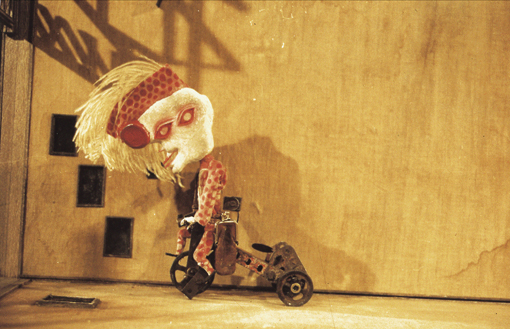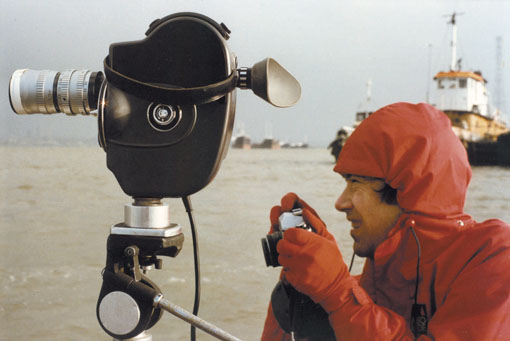Studying Experimental Film and Video
William Fowler, Curator of Artists’ Moving Image for the BFI, looks at some of the wide variety of resources available to those studying the moving image work of British artists.
About the author: William joined the BFI in 2005 as the archive’s first dedicated curator of artists’ moving image. Since then he has undertaken a number of film restoration projects, seasons and DVD releases. He conceived and co-programmes the BFI Southbank strand Essential Experiments and co-conceived and co-programmes with Vic Pratt the popular monthly programme The Flipside; he also presents films internationally. He has written for The Guardian, Sight & Sound, Eikon and Framework, as well as BFI Screenonline and the Mediatheques. His curatorial projects have included Gazwrx: The Films of Jeff Keen, Here’s a Health to the Barley Mow and Visionary Landscapes - the last presented with LUX. His BFI DVD and film season The Lacey Rituals: Films by Bruce Lacey (and Friends), which featured a brand new film by Nick Abrahams and Turner Prize-winner Jeremy Deller, was launched in 2012.
This article first appeared in Viewfinder 66.
University courses are increasingly focusing on artists’ film and video, whether as part of a film studies course or a more practical production-led art school study. This is perhaps reflected and enabled by a dialogue between a perceived maturation of the subject – we have more distance from the beginnings of the modern epoch of the late ‘60s and ‘70s – and the increasing availability of material and resources. The latter has benefited enormously from the technological developments affecting all areas of media production and study. This raises interesting questions in the particular context of artists’ works, however, as historically the area has tended to concern itself at least in part with the very context and carrier by which its ‘message’ is relayed. Correspondingly then concerns about the transmission of work and ideas become increasingly challenging for both the artist and the researcher working today. As such it is worthwhile for students of this area to think about this as they also engage in the reception of information. This is in part what can make this work, and its study, so thought provoking.

Still from 'The Unnamable Little Broom' (1986) (image: BFI)
This raises the question – where can you actually see artists’ works? There are in fact several outlets and opportunities. Many of the major galleries in cities around the country screen artists’ work whether as part of a contemporary show or as a part of a touring programme. These include the Arnolfini in Bristol, FACT in Liverpool, the Baltic in Gateshead, Ikon in Birmingham, the Norwich Gallery and also the Whitechapel Gallery in London which has an adjunct film curator. LUX and the Independent Cinema Office also arrange touring programmes that may feature in local repertory cinemas. Information about these and other screenings can be found at www.lux.org.uk and www.independentcinemaoffice.org.uk. There are also frequent screenings of artists’ works at the Tate Modern and increasingly now at the BFI Southbank (www.bfi.org.uk/).
There are also less structured opportunities for watching artists’ film and video through the increasing amount of commercially available DVDs and the different sites available for research viewing. Many of these are aimed at students and give preferential rates. The BFI, LUX and St Martins British Artists’ Film and Video Study Collection all provide on-site viewing. The BFI offers access through its broader viewing service – click here for information. The BFI has a range of material from early avant-garde cinema to an increasing amount of contemporary artists’ works complimenting the range of master material gathered for the BFI National Archive. There are also a number of DVD releases from the BFI, mostly notably the Arts Council England supported British Artists’ Film series. These so far include William Raban and Chris Welsby with Ian Breakwell and Jayne Parker soon to follow. This series includes a selection of films by the artists, sometimes including documentation of expanded pieces, an interview with the artist and a detailed filmography. There are also DVDs of shorts by the Brothers Quay, recently released features by the late Derek Jarman and an on-going decade-by-decade series on the history of avant-garde cinema.
LUX provides several research and viewing outlets, drawing on contemporary works and a rich back catalogue from the London Filmmaker’s Coop and London Electronic Arts. You can book time to watch material in their office in East London. Building on their curated touring programmes, LUX have also released on DVD, Margaret Tait Selected Films 1952 – 1976, about the Scottish artist filmmaker, and Shoot Shoot Shoot - British Avant-Garde Film Of The 1960s & 1970s, celebrating the first ten years of the London Filmmaker’s Coop. The Shoot DVD comes with an informative booklet about this early history written by the project curator, Mark Webber and includes films by Malcolm Le Grice, Guy Sherwin, Mike Leggett, Peter Gidal, Stephen Dwoskin, Jeff Keen, William Raban, Chris Welsby, Annabel Nicolson, David Crosswaite, Lis Rhodes, Marilyn Halford and John Smith.
LUX also have another more expensive series of artists DVDs available exclusively to colleges and libraries and subsequently charged at a higher rate, called After Image. Each disc focuses on a specific artist and includes some of their key works. The first two volumes are on Malcolm Le Grice and Peter Gidal, both driving forces at the Coop and titles devoted to the work of Lis Rhodes and Vivienne Dick are forthcoming. Information about these and other artists is available at the LUX sister site, www.luxonline.org.uk/. This site is a great place to both start and continually refer back for study in this field. Constructed and curated through collaboration with both the artists represented and other curators, this comprehensive site includes moving image files, stills, articles and tours around the site.
Another excellent and thorough resource linking broader activity and information is the St Martins British Artists’ Film and Video Study Collection (www.studycollection.org.uk/). This holds a significant paper collection as well as video tapes and DVDs of many artists’ titles. Perhaps the most unique resource within the Study Collection is the British Artists’ Moving Image Database. Incredibly useful for tracking down material, this provides information about several thousand works including location and holdings in public and academic collections. The Study Collection website also holds online curated exhibits which act as showcases for the paper and special materials in the collection. The Electronic and Digital Art Unit at the University of Central Lancashire is also developing a study collection and the artist video project, Rewind, and the University of Dundee has a selection of works available for research viewing plus an on site database at www.rewind.ac.uk/rewind/

William Raban directing 'Thames Film' (1986) (image: BFI)
Many books have been written about artists’ film and video, including several that are now out of print. The study of the field itself then has its own history and legacy. Some of the most recent titles to be published include David Curtis’s A History of Artists’ Film and Video in Britain, and Chris Meigh-Andrew’s A History of Video Art: The Development of Form and Function. Curtis’s comprehensive book is being supported by a series of complimentary screenings (also programmed by Curtis) at the BFI Southbank. The book and the screenings together would make a very good primer for potential students of the field. Meigh-Andrew’s book, amongst other things, reflects his work on the Analogue research and touring project (see weblinks below). Other recent books that offer overviews of the field include:
- Video Art: A Guided Tour by Catherine Elewes (IB Tauris, 2005)
- Film Art Phenomena by Nicky Hamlyn (BFI, 2003)
- Diverse Practices: A Critical Reader on British Video Art ed. Julia Knight (University of Luton Press, 1996)
- Experimental Cinema in the Digital Age by Malcolm Le Grice (BFI, 2001)
- The British Avant-Garde Film: 1926-1995, an Anthology of Writings by Michael O’Pray (University of Luton Press, 1995)
- A History of Experimental Film and Video by A.L. Rees (BFI, 1999; 2nd edition 2011, reviewed here)
If you are interested in reading more widely and/or about specific artists, luxonline accompanies all their featured artists with a list of appropriate articles and books. In fact, many of the websites listed in this article contain links and leads to follow for possible further study.
William Fowler
STUDY RESOURCES ON THE INTERNET FOR BRITISH ARTISTS’ MOVING IMAGE
Many of the activities and organizations listed here are discussed in greater detail in the main body of this article. Also, many practicing artists and galleries maintain their own websites, often providing comprehensive information about production and screenings.
Analogue: Pioneering Video from the UK, Canada and Poland (1968-88) www.uclan.ac.uk/research/environment/groups/electronic_digital_art_unit.php This video art research project has a screening programme currently touring internationally. The Electronic and Digital Art Unit at the University of Central Lancashire, led by Dr. Chris Meigh-Andrews and from which the project comes, is also developing a video study collection.
British Artists’ Film and Video Study Collection at Central Saint Martins College of Art and Design www.studycollection.co.uk/ Includes the British Artists’ Moving Image Database providing information and locations for thousands of works. Also details about the paper and viewing material accessible at the collection. These are also highlighted through the site’s curated on-line exhibitions.
BFI www.bfi.org.uk Links to information about archival viewing services including on-site research viewing and free viewing in the Mediatheque (including the curated artist strand, Borderlines), the BFI library, artist books and DVDs for sale and details about the BFI Southbank gallery space and screenings at the NFT.
Screenonline www.screenonline.org.uk This BFI educational site for screen studies includes essays, clips and whole films from British film and television, including entries on artists and artists’ works. screenonline has recently adopted a new address recognition system (q.v. page 5, Other News), easing and increasing access to the available moving image material.
Flicker www.hi-beam.net Discussion list and magazine for experimental film with an accessible postings archive. Tends to be American focused.
LUX www.lux.org.uk This site provides access to the LUX distribution catalogue, information about projects and educational resources, up and coming events - LUX and otherwise, essays about artists, and a shop for DVDs and books.
www.luxonline.org.uk/ An expansive resource for researching and learning about artists’ moving image work which includes clips, stills, articles, tours, chronologies and more.
Picture This www.picture-this.org.uk/ This Bristol based artists’ moving image commissioning agency has produced several books and DVDs on various artists including, amongst others, John Smith and John Wood and Paul Harrison. A DVD on Marcus Coates is forth coming. Details about purchase and other Picture This projects and activities are available on their website.
RaroVideo www.rarovideo.com Italian DVD label specializing in alternative film from experimental to horror. Sells two DVDs of Derek Jarman’s super-8 films now with European and US stables.
Re-Voir www.re-voir.com French-based DVD and video publisher of international experimental film. It represents a substantial range of artists including the British artist Len Lye and the British based Steve Dwoskin.
Rewind – Artists Video in the 70s & 80s www.rewind.ac.uk/ This research resource for ‘70s and ‘80s British artists’ video is based at Duncan of Jordanstone College of Art & Design, University of Dundee and led by Prof. Stephen Partridge and Dr. Jackie Hatfield. The site provides access to the project database and information about viewing material.
Tate Research www.tate.org.uk/research/ Gives information about the available research services at the Tate galleries– with library and archive databases, plus access to the illustrated collection database – which includes some installations, video and film. The Tate galleries, in London, Liverpool and St. Ives also screen work in exhibitions and in the auditoria.
Video Art: The Early Years ukvideoart.tripod.com/ This chronology provides a very good overview of the variety of exhibitions, developments and events surrounding British artists’ video from 1971 to 1993.